环糊精功能化碳纳米材料的制备及电化学分析研究进展
易银辉,孙 恒,钱俊娟,朱刚兵
(江苏大学 环境与安全工程学院,江苏 镇江 212013)
环糊精功能化碳纳米材料的制备及电化学分析研究进展
易银辉,孙 恒,钱俊娟,朱刚兵
(江苏大学 环境与安全工程学院,江苏 镇江 212013)
环糊精(CD)是一种具有腔内疏水、腔外亲水特殊性质的分子,其内腔具有很高的分子识别和富集能力,同时外腔具有很好的溶解性。另外,碳纳米材料具有大的比表面积和良好的电学性能等优点,在电分析化学领域具有重大的应用价值,然而纯碳材料通常在溶剂中不易分散。因而发展有效的方法将CD功能化到碳纳米材料表面是一个非常有意义的课题:CD不但能使碳纳米材料的分散性得到改善,同时使其具有良好的分子识别与富集性能而表现出极高的电化学分析能力。本文主要论述了CD功能化各种碳纳米材料(碳纳米管、石墨烯、碳空心球等)的方法、原理以及在电化学分析中的应用,最后,简要论述了该领域所面临的挑战及未来的发展方向。
环糊精;碳纳米管;石墨烯;碳球;电分析化学
环糊精(CD)是由直链淀粉在环糊精葡萄糖基转移酶作用下生成的含有6~12个D-吡喃葡萄糖单元的一系列环状低聚糖。目前研究较多且最为重要的是含有6,7,8个葡萄糖单元的分子构成的环糊精,分别命名为α-环糊精(α-CD)、β-环糊精(β-CD)和γ-环糊精(γ-CD)[1,2]。CD具有腔外亲水、腔内疏水的特殊性质。它的疏水空腔具有很高的分子识别和富集能力,可选择性地识别许多有机和无机分子;其外腔良好的水溶性能够使得CD作为纳米材料表面功能化分子,使许多非水溶性的材料得到良好的分散能力[3-5]。
许多碳材料,如富勒烯、碳纳米管(CNTs)、石墨烯(RG)、碳纳米球、碳量子点,具有许多独特的物理化学性能:大的比表面积、良好的导电性和电催化性能、稳定的力学和热力学性能,目前已广泛应用于电化学分析领域[6-9]。但是,由于纳米碳材料分子量比较大,相互之间存在较强的范德华力,同时纳米碳材料具有巨大的比表面积,使得纳米碳材料之间吸附性特别强、极易发生团聚和缠绕,进而导致它在各种溶剂中的溶解性极差、易于团聚,这对构建应用于电化学分析的各种修饰电极存在严重限制[10,11]。因此,对纳米碳材料在电化学传感中的应用研究中,大部分需要将纳米碳材料进行表面功能化处理,以使其更好地分散在特定的溶剂中[12,13]。
目前,采用环糊精对纳米碳材料进行功能化是极为热门的一个研究课题。研究者们通过将CD分子功能化到纳米碳材料表面,不但使得碳材料在溶剂中获得很好的分散性,同时由于CD分子的分子识别与富集能力,从而使获得的复合材料具有更高的电化学传感能力。为此,本文主要综述了CD分子功能化CNTs,RG等纳米碳材料的制备方法及在电化学分析中的研究进展。
1 CD功能化CNTs
CNTs是1991年由日本物理学家饭岛澄男从电弧法生产的碳纤维中发现的一种管状碳单质,它是按一定的螺旋度卷曲而成的,具有典型的层状中空结构特征。管上每个碳原子采取sp2杂化,相互之间以碳-碳σ键结合起来形成六角形组成的网格结构作为CNTs的骨架。依据碳原子层数的不同将CNTs分为两类:多壁碳纳米管(MWCNTs)和单壁碳纳米管(SWCNTs)。CNTs具有许多优异的性能:电子迁移率高(1000~2000S/cm)、理论比表面积大、化学及物理稳定性好、机械强度高[8,14-16]。为改善CNTs在溶剂中的分散性,研究者们以不同方式制备了许多CD功能化CNTs材料,通过结合CD和CNTs的协同能力,发展了多种电化学传感器。
在早期,研究者们通常只是简单地将CD和CNTs一起混合于溶剂中,利用CD和CNTs之间的物理作用力将CNTs分散。通过这种方法获得的CD/CNTs复合材料已被广泛地应用于电化学检测芦[17]、络氨酸[18]、苯二酚[19]、金霉素[20]等目标物。比如,通过将MWCNTs分散于溶有β-CD的DMF溶液中,并取一定的该混合液修饰玻碳电极(GCE)表面,Shen和Wang[21]制备了β-CD/MWCNT/GCE,然后将该修饰电极同时用于鸟嘌呤、腺嘌呤和胸腺嘧啶的电化学传感研究。实验证实,在裸GCE上,仅出现腺嘌呤和胸腺嘧啶两个微小驼峰,鸟嘌呤并没有出现任何峰电流。然而,在β-CD/MWCNT/GCE上,腺嘌呤和胸腺嘧啶的两个峰的响应电流明显提高,同时,也能检测到鸟嘌呤的氧化峰电流(如图1所示)。通过将β-CD聚合物和MWCNTs在水中超声2h,Diao[22]课题组制备了β-CD聚合物功能化MWCNTs复合物,并将该复合物应用到二茂铁甲醇和对氨基苯硫酚的超分子识别。发现通过这种混合方法制备环糊精功能化碳纳米管非常简单,但是它存在一些缺点:所获得的复合物表面形貌和结构不均匀,且由于CD和CNTs间的结合力较弱,导致CD分子容易脱离CNTs表面,从而影响电化学传感器的稳定性和灵敏度。

图1 0.1mol·L-1 PBS (pH 7.2)溶液中,30μmol·L-1 A,100μmol·L-1G和200μmol·L-1T在不同电极上的DPV图[21]Fig.1 Differential pulse voltammetric study of 30μmol·L-1 A,100μmol·L-1 G and 200μmol·L-1 T at different electrodes in 0.1mol·L-1 PBS (pH 7.2)[21]
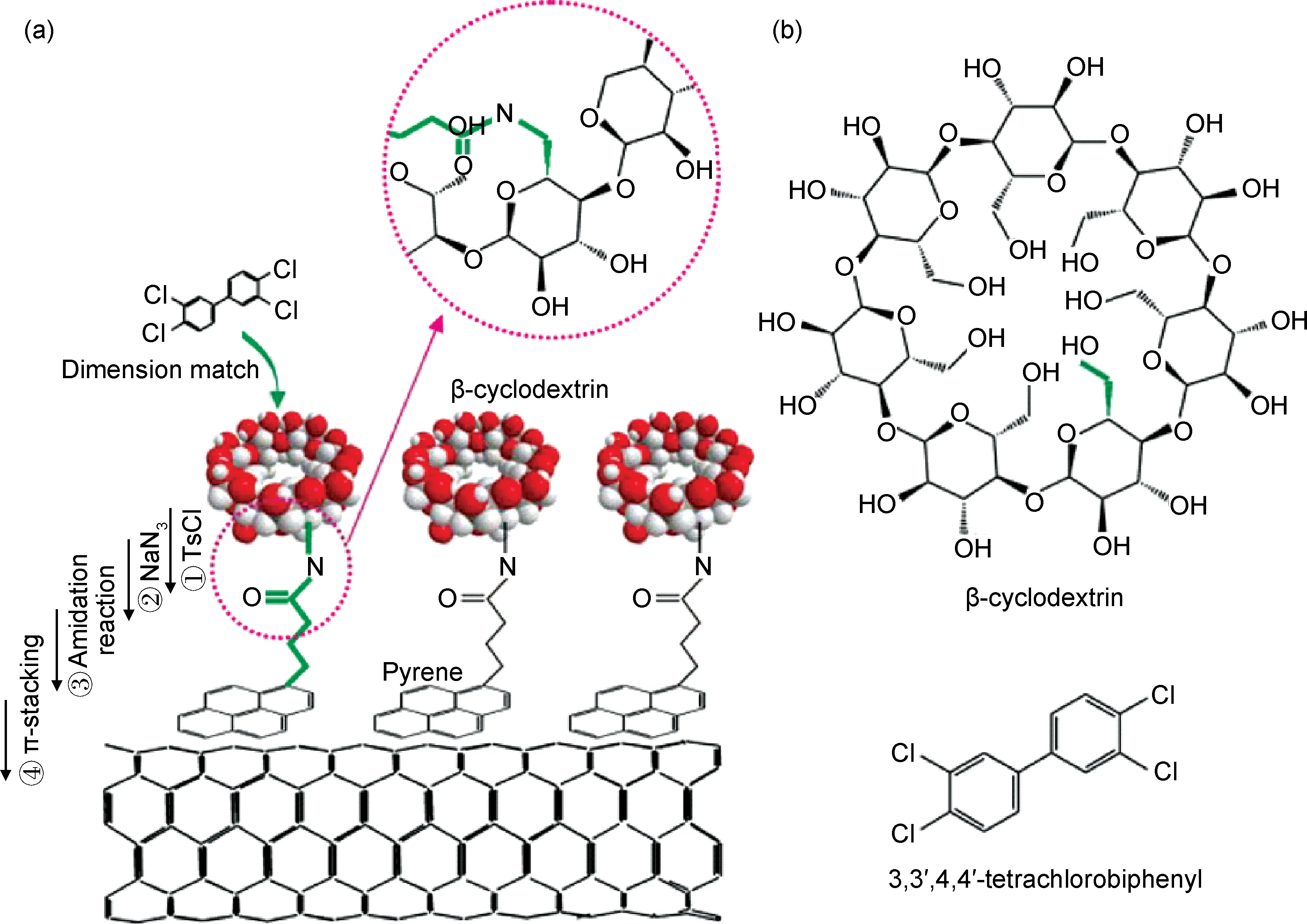
图2 SWCNTs通过π-π共轭吸附PyCD示意图(a)和β-CD与3,3′,4,4′-四氯联苯的化学结构图(b)[23]Fig.2 Schematic diagram outlining the irreversibly adsorbing of PyCD onto the sidewall of a SWCNTs via π-π stacking (a) and chemical structures of β-CD and 3,3′,4,4′-tetrachlorobiphenyl (b) [23]
最近,Wang和Huang等[23]制备了芘环糊精(PyCD)功能化SWCNTs(PyCD/SWCNTs)复合物修饰GCE,并采用电化学阻抗方法实现了对3,3′,4,4′-四氯联苯的检测。由于芘基官能团的存在,通过π-π 共轭作用PyCD可以牢固地结合到SWCNTs表面。当目标物3,3′,4,4′-四氯联苯分子被PyCD分子内腔捕获时,会形成主客共轭包络物,并对PyCD内腔产生封闭作用,从而导致氧化还原探针无法到达电极表面,造成电化学阻抗值增加,基于此原理实现对3,3′,4,4′-四氯联苯的电化学测定(如图2所示)。之后,该课题组继续将所制备得到的PyCD/SWCNTs复合物应用于对硝基苯酚的电化学测定[24]。由于PyCD与对硝基苯酚及其他客体分子的结合系数不同,从而可实现对对硝基苯酚的高选择性检测。此外,由于连接PyCD和SWCNTs的π电子系统(芘环)的快速电子迁移,从而可实现对目标物的高灵敏检测。实验结果显示,PyCD/SWCNTs/GCE对对硝基苯酚的检测灵敏度高达18.7μA/(μmol·L-1),检测限低至0.00086μmol·L-1。
苝四酸(PTCA)是同时拥有芘基和4个羧基的有机分子,其4个羧基可以跟氨基发生酰胺化反应。在另一篇报道中,通过芘基和SWCNTs间的π-π堆积作用,Chen等[25]首先制备了PTCA修饰SWCNTs,然后利用氨基被它环糊精(NH2-β-CD)与PTCA的酰胺化反应,成功地制备了β-CD非共价修饰SWCNTs复合物(β-CD-PTCA-SWCNTs),并将该制备的复合物应用于对9-恩甲酸(9-ACA)的电化学传感研究中(如图3所示)。由于SWCNTs优良的电学性能以及β-CD的分子识别性,9-ACA在β-CD/PTCA/SWCNTs修饰GCE表面的氧化峰电流分别是SWCNTs/GCE、裸GCE的4和31.2倍。电化学检测9-ACA的线性范围是2~140nmol·L-1,检测限达到0.65nmol·L-1。
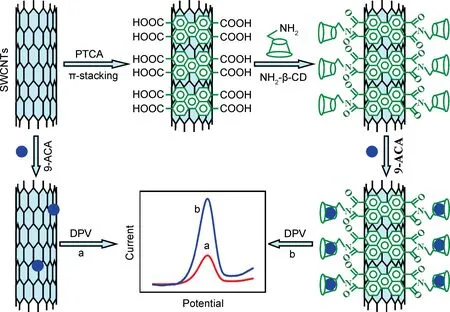
图3 β-CD-PTCA-SWCNTs的制备及电化学传感示意图[25]Fig.3 Scheme of preparing β-CD-PTCA-SWCNTS and electrochemical sensing[25]
通过共价方法制备CD功能化CNTs复合物同样是一个非常热门的研究方向。比如,Wang等[26]通过将SWCNTs和单-6-脱氧-6-(对氨基二苯胺)-β-CD(PCD)进行原位叠氮化反应,制备了PCD共价功能化SWCNTs复合物。PCD不但可以提高SWCNTs在溶剂中的分散性,同时可显著提高传感器的灵敏度和选择性。之后,他们利用所获得的复合物实现了对多种持久性有机污染(2,4,5-三氯联苯,氯丹,艾氏剂和六氯苯)的高灵敏和选择性电化学检测(如图4所示)。同时,Li等[27]通过单-6-脱氧-己二胺-β-CD(MH-β-CD)和SWCNTs-COOH间的酰胺化反应制备了MH-β-CD/SWCNTs复合物,并将MH-β-CD/SWCNTs应用到了双酚A的电化学检测。结果显示,MH-β-CD/SWCNTs复合物对双酚A具有很高的电催化能力,同时由于MH-β-CD(高的分子识别与富集能力)和SWCNTs(良好的电催化性能和大比表面积)的协同能力,对双酚A的检测限低至1.0nmol·L-1。
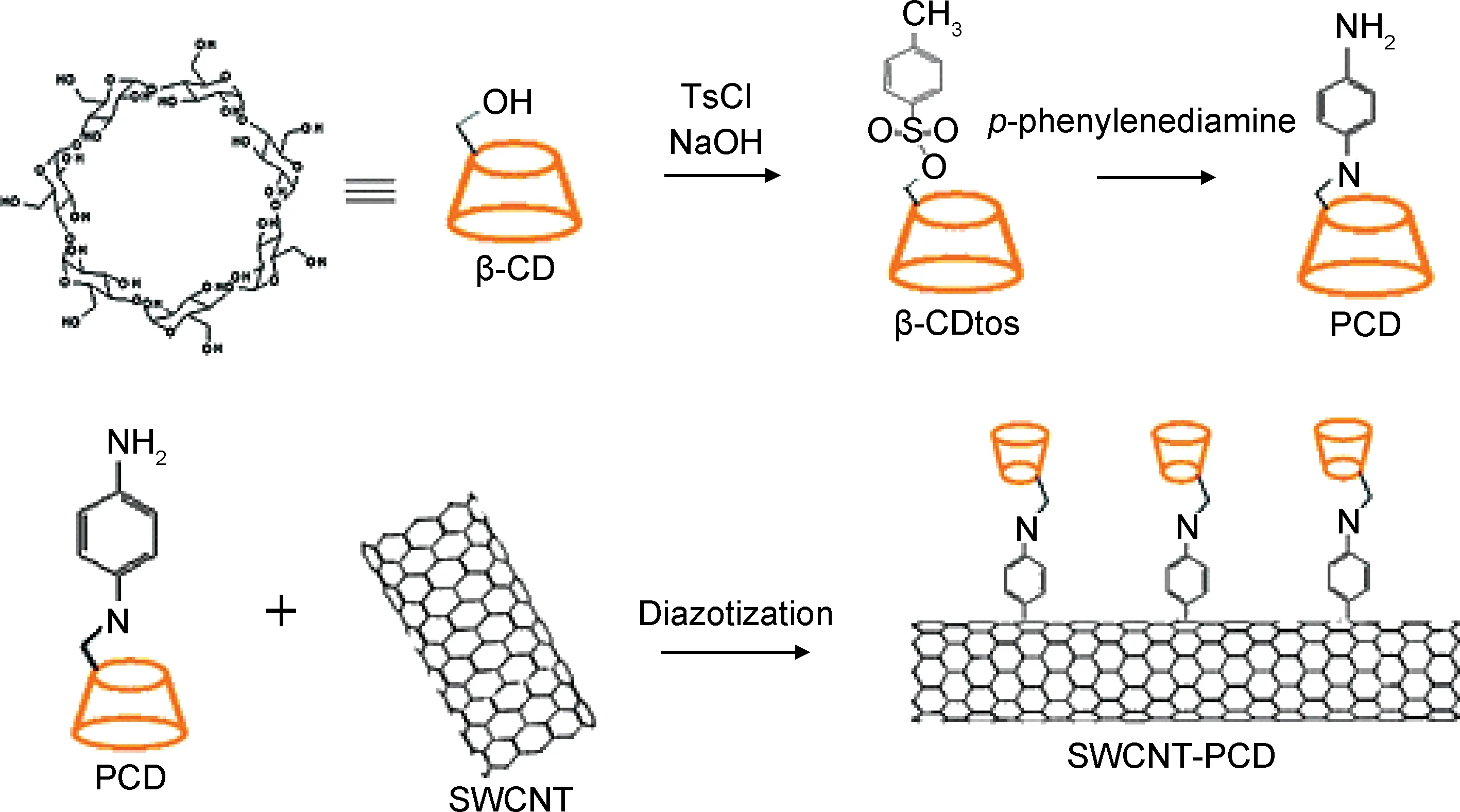
图4 PCD和SWCNT-PCD的制备示意图[26]Fig.4 Schematic representation of synthesis of PCD and preparation of SWCNT-PCD hybrids [26]
上述这些CD功能化CNTs的制备方法通常采用的是单一的CD分子,最近有研究发现,通过两种不同种类的CD分子进行交联后可以比单一的CD分子显示出更高的分子识别与结合能力[28]。比如,Zhao和Li课题组[10]制备了双巯基桥接β-CD二聚物功能化MWCNTs(DBβ-CD/MWCNTs)复合物用于同时电化学检测3种酚类:4-氨基苯酚、4-氯苯酚和4-硝基苯酚。实验结果证实,DBβ-CD/MWCNTs修饰电极比单一CD功能化MWCNTs和纯MWCNTs具有更好的电化学传感能力。
在这部分,系统地总结了各种制备CD功能化CNTs的方法、机理以及在电分析化学中的应用。由于CD/CNTs复合物具有CD分子和CNTs二者的协同能力,使获得的复合物具有优越的电化学传感性能。从上述看出,目前基于CD/CNTs复合物检测的目标物大部分是环境有机污染物分子,其原因可能是这些有机分子通常是疏水性的,易与CD分子内腔结合,进而使得传感器具有更高的灵敏度。
2 CD功能化RG
RG是一种由碳原子构成的单层片状结构的新材料,只有一个碳原子厚度。它目前是最理想的二维纳米材料。理想的RG典型结构是平面六边形点阵,是一层被剥离的石墨分子。RG上的碳原子都是采用sp2杂化,并贡献一个剩余p轨道上的电子从而形成大π键,π电子可以自由移动,赋予RG良好的导电性。由于RG具有极大的比表面积(2630m2/g)和电子迁移率(电阻率仅为10-6Ω·cm),因而它已被广泛地应用于构建各种电化学传感器[6,29-32]。相比CNTs,RG具有两个明显的优点:(1)不存在金属杂质,(2)制备RG的原材料是非常廉价易得的石墨[31,33]。因此,制备CD功能化RG复合物并将其应用于电化学分析领域受到了广泛关注,尤其是自2010年后,发表的相关文章大量增加[34,35]。以下本文将对CD功能化RG及其电化学分析应用进行综述。
2010年,Dong和Wang等[36]采用简单的湿化学法制备了β-CD功能化RG(β-CD/RG),其过程为先将β-CD和氧化石墨烯在水中混合均匀,之后采用水合肼进行还原。最后所获得的复合物可以在各种溶剂中表现出极好的分散性和稳定性。为探索β-CD/RG的电化学传感性能,他们将其应用到了8种分子(多巴胺,尿酸,降肾上腺素,酪氨酸,色氨酸,对乙酰氨基酚,芦丁和硫醚嗪)的电化学传感研究。研究结果证实,β-CD/RG具有非常高的分子识别与富集能力,比单独的RG或CNTs具有更高的电化学响应性能。由于这种制备β-CD/RG复合物的方法简单、成本低,因而通过这种湿化学法制备的β-CD/RG被科学家广泛地应用于电化学检测多菌灵[37]、氯酚[38]、硝基酚[39]、甲氨蝶呤[40]等目标物。同时,该复合物还被用到了胆固醇的非酶电化学传感研究中[41],在这篇报道中,亚甲基蓝作为一个氧化还原探针,它可以与β-CD形成包络物,当目标物胆固醇存在时,由于它与β-CD间的结合系数大于亚甲基蓝和β-CD的结合系数,导致β-CD内腔的亚甲基蓝分子被胆固醇取代,进而使得探针分子亚甲基蓝的响应信号降低,从而实现对胆固醇的定量测定。在另一篇报道中,研究者通过同样的方法制备了α-CD/RG复合物并用于电化学检测蛋氨酸[42]。
为进一步改善β-CD/RG复合物的导电性和电催化性能,Chen等[43]将贵金属铂纳米粒子引入到了β-CD/RG表面,并将获得的三元杂化物应用于1-和2-萘酚的电化学分析研究。利用该杂化物中β-CD,RG,铂三者的协同能力,实现了对两种萘酚的高灵敏电化学检测。
之后,科学家使用各种不同的CD分子衍生物用来制备CD/RG复合物。比如,在微波辅助下,Wang等[44]制备了羟丙基-β-CD功能化RG复合物,并将该复合物修饰GCE用于电化学检测多种酚类有机污染物(如图5所示)。同时,Wang等[45]也利用该复合物同时测定重金属铅(II)和镉(II)。在另一篇报道中,研究者采用湿化学法制备了2,6-二甲基-β-CD功能化RG复合物,并将该复合物用以构建电化学检测异槲皮苷和黄芩苷的电极修饰材料[46]。另外一种环糊精衍生物,脱氧-(2-氨乙基氨基)-β-CD(DA-β-CD)也被用来功能化RG[47],其原理是通过EDC/NHS活化,使DA-β-CD和氧化石墨烯发生酰胺化反应并还原,从而获得DA-β-CD共价功能化RG复合物。相比于β-CD ,DA-β-CD具有更高的水溶性和分子识别能力[48]。相比于二维石墨烯,三维结构石墨烯具有更大的比表面积。最近,有报道采用三维氮掺杂石墨烯(3D-NG)作为固定CD分子的电极修饰材料,并发展了一种新型传感器[49]。掺杂的氮不但可以增加复合物的导电性,同时由于可以和β-CD分子通过氢键等作用力结合,增加RG表面的β-CD分子负载量,进而提高复合物对客体分子的富集能力。为进一步探索这种复合物的电化学传感性能,研究者将复合物应用于多巴胺和对乙酰氨基酚的电化学测定(如图6所示)。实验结果证实,3D-NG/β-CD对多巴胺和对乙酰氨基酚检测的灵敏度分别高达5468.6μA·mmol-1·L·cm-2和 2419.2μA·mmol-1·L·cm-2,线性范围分别是10~140μmol·L-1和10~250μmol·L-1。
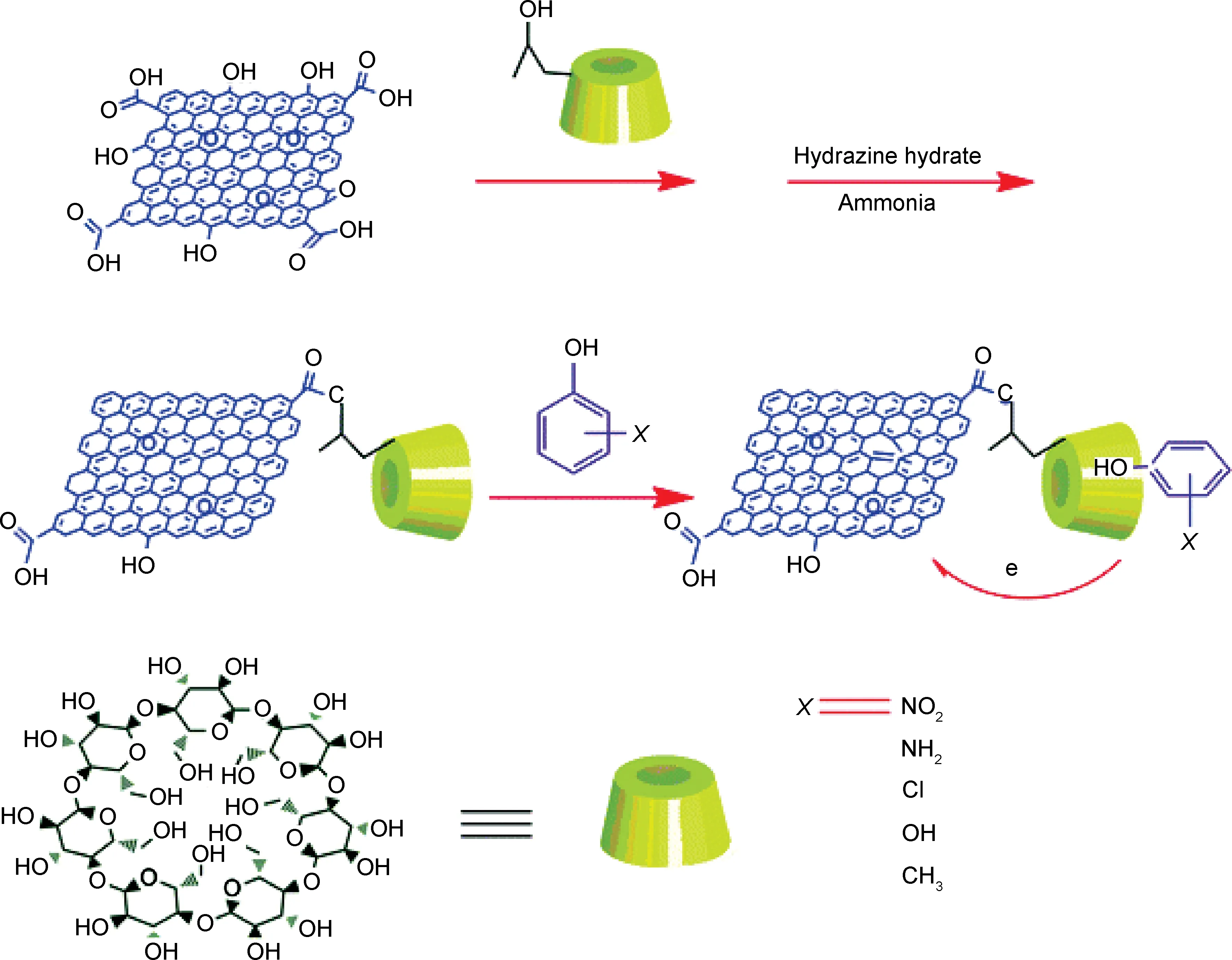
图5 HP-β-CD-RG复合物制备主(HP-β-CD)客(邻硝基酚)共轭示意图[44]Fig.5 Schematic diagram for the synthesis procedure of HP-β-CD-RG composites and the interaction between the guest (o-nitrophenol) and the host (HP-β-CD moiety linked up to RG) [44]
石墨烯纳米带(GNRs),是一种石墨烯宽度限制在100nm 以下得到的产物,其结构介于一维碳纳米管和二维石墨烯纳米片之间,它是继CNTs和石墨烯片之后被广泛关注的一类新型准一维碳基纳米新材料。相比于石墨烯纳米片,GNRs具有较大的长宽比,其限域的宽度和丰富的边缘构型使它具有许多不同于石墨烯片的性质和应用,同时具有比石墨烯片更灵活可调的性质和更大的实用价值[48,50,51]。最近,本课题组在GNRs的CD功能化方面进行了一些研究,比如通过氧化剥离CNTs的方法制备了氧化石墨烯纳米带,之后采用湿化学法通过2-羟丙基-β-CD对其进行功能化并还原,获得了β-CD功能化GNRs复合物,并采用对氨基酚、L-酪氨酸和罗丹明B作为探针分子探究了所制备复合物的电化学传感性能[52]。同时,通过部分剥离碳纳米管,制备了GNRs包覆碳纳米管复合物(CNTs@GNRs),之后通过电聚合将β-CD和L-精氨酸功能化到CNTs@GNRs修饰电极表面(如图7所示),利用β-CD,L-精氨酸和CNTs@GNRs的协同能力同时实现了对2-和4-氨基酚的电化学检测[53]。
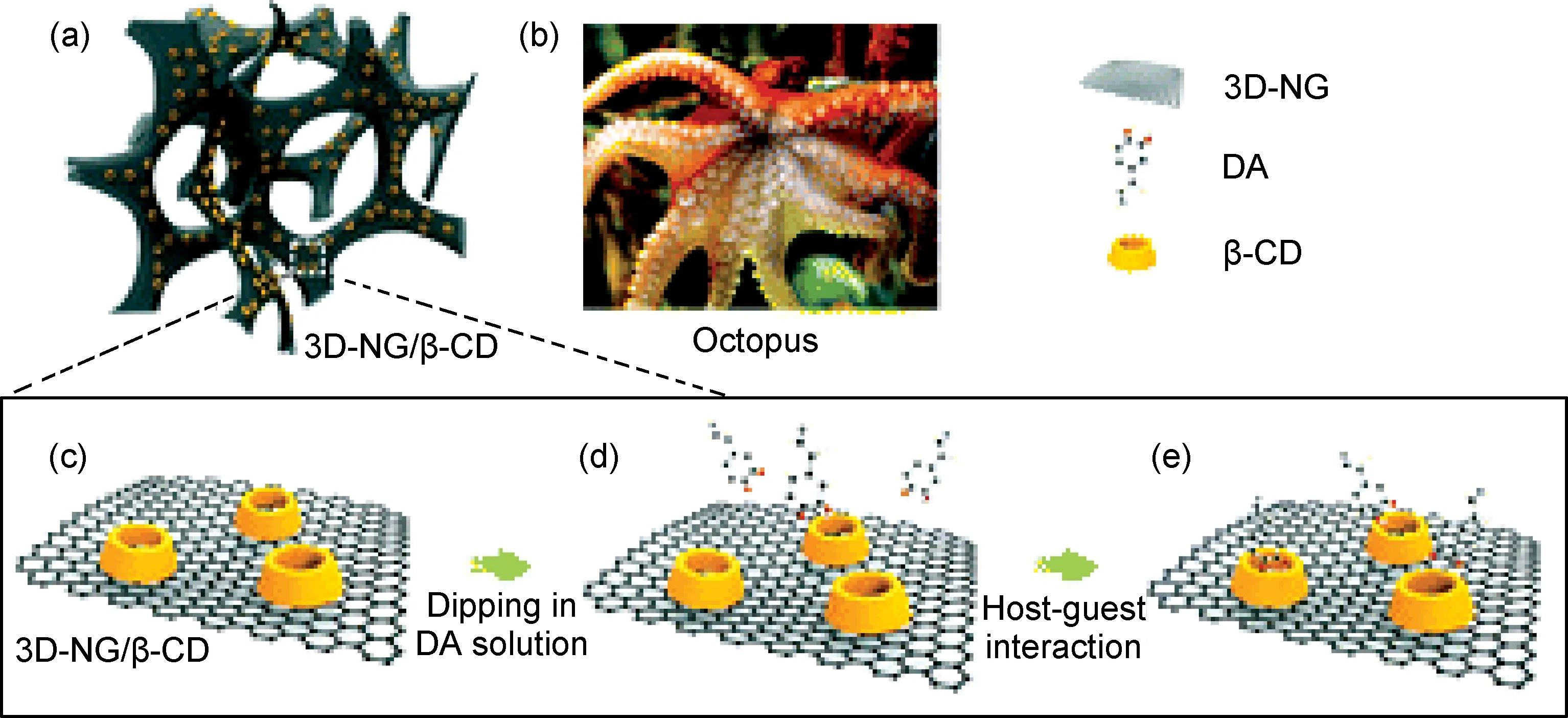
图6 3D-NG/β-CD制备及主客共轭示意图[49]Fig.6 Process for preparing 3D-NG/β-CD and the host-guest interaction[49]
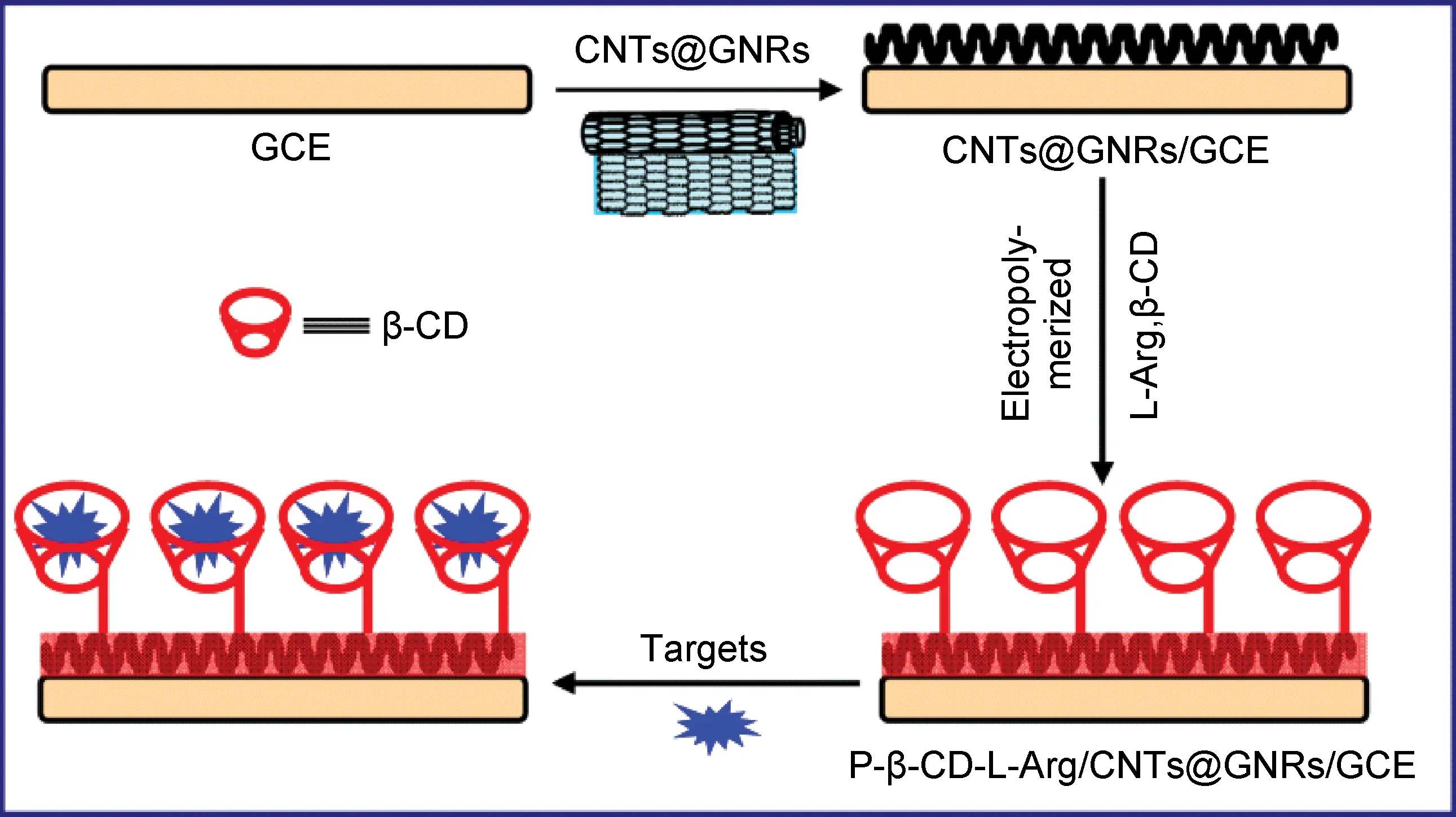
图7 P-β-CD-L-Arg/CNTs@GNRs/GCE的制备及电化学传感2-和4-氨基酚的示意图[53]Fig.7 Schematic diagram for preparing P-β-CD-L-Arg/CNTs@GNRs/GCE and electrochemically sensing 2- and 4-AP [53]
系统地综述了各种制备CD功能化RG的方法及其电化学分析应用进展。可以看出,目前制备CD/RG的方法主要有共价和非共价方法,由于CD和RG的协同性能,CD/RG复合物已被大量地应用于有机污染物、重金属和生物分子的电化学检测。基于CD/RG发展的电化学传感器将产生重大的实际应用价值。
3 CD功能化其他纳米碳材料
由于碳材料具有许多优异的性能以及CD的分子识别与富集性能,研究者也在其他碳材料的CD功能化及其电化学分析应用领域进行了研究。比如,Nan等[54]通过将β-CD与碳纳米片混合超声均匀,并取一定量的分散液滴至GCE电极表面制备了β-CD/碳纳米片修饰电极,最后将该电极用于电化学检测芦丁。实验结果显示,该修饰电极比碳纳米片修饰电极具有更高的电化学传感能力,对芦丁的电化学检测线性范围是0.3~15μmol·L-1,检测限是0.09μmol·L-1。为实现对手性分子色氨酸单体的手性识别,Kong[55]和Huang[56]课题组通过电沉积技术分别制备了β-CD/石墨烯量子点修饰电极和β-CD/N-碳点修饰电极,并应用于D和L型色氨酸分子识别。空心结构的纳米碳材料(碳空心球、碳空心管等)因为其热稳定性和化学稳定性高、比表面积可控、中空结构能容纳大分子等特点,成为近10年碳材料家族中研究的热点之一[57]。最近,为实现对邻苯二酚和对苯二酚高灵敏电化学检测,本课题组通过“金巯”键合作用将巯基-β-CD功能化到纳米金/空心碳纳米球(AuNPs/HCNS)表面,制备了具有β-CD、AuNPs(电催化性能高)和HCNS(比表面积大和吸附能力强)三者协同能力的新型三元纳米复合物,利用该复合物优异的电化学传感能力,实现了对多个目标物的高灵敏电化学测定。实验结果证实,该三元复合物对邻苯二酚和对苯二酚的检测限分别低至0.01μmol·L-1和0.02μmol·L-1[58]。
4 结束语
采用CD分子对纳米碳材料进行表面功能化不但可以改善其在各种溶剂中的分散性,同时使获得的复合物具有CD分子和碳纳米材料的协同能力而表现出优异的电化学传感性能。目前,科学家已发展了多种共价和非共价方法用以制备CD功能化碳纳米复合物,其主要集中于CNTs和RG的功能化,而对于CD功能化富勒烯、碳纳米球和碳量子点等其他碳纳米材料的研究较少。
非共价法主要用于CNTs的CD功能化,而共价法主要用于RG的CD功能化。其原因是CNTs表面通常缺少活性基团、难以发生化学反应;而RG的前驱体氧化石墨烯表面具有许多羧基、羟基等活性基团,很容易与其他物质发生共价反应。
CD功能化碳纳米材料已广泛地应用于各种客体分子(有机污染物、重金属、生物分子)的电化学测定,具有重大的实际应用价值。但是,也存在一些挑战:
(1)更简单的制备方法。目前在制备环糊精功能化碳材料通常程序复杂、耗时、产率低,因此发展更加简单、高效的方法具有重大意义。
(2)拥有更高的电化学传感性能。为满足低痕量测定,发展具有更高电化学传感性能的环糊精/碳纳米材料是一个重大挑战。
(3)可进行原位检测。发展便携式稳定的基于环糊精/碳纳米材料的电化学传感器用于环境和生命的原位检测依然是我们面临的一个需要解决的问题。
[1] LI F, ITO T. Complexation-induced control of electron propagation based on bounded diffusion through nanopore-tethered ferrocenes [J]. Journal of the American Chemical Society, 2013, 135(44): 16260-16263.
[2] GONG J, HAN X, ZHU X, et al. Layer-by-layer assembled multilayer films of exfoliated layered double hydroxide and carboxymethyl-β-cyclodextrin for selective capacitive sensing of acephatemet [J]. Biosensors and Bioelectronics, 2014, 61: 379-385.
[3] SZENTE L, SZEMN J. Cyclodextrins in analytical chemistry: Host-guest type molecular recognition [J]. Analytical Chemistry, 2013, 85(17): 8024-8030.
[4] NI J, SHAN C, LI B, et al. Assembling of a functional cyclodextrin-decorated upconversion luminescence nanoplatform for cysteine-sensing [J]. Chemical Communications, 2015, 51(74): 14054-14056.
[5] YAO J, YAN Z, JI J, et al. Ammonia-driven chirality inversion and enhancement in enantiodifferentiating photocyclodimerization of 2-anthracenecarboxylate mediated by diguanidino-γ-cyclodextrin [J]. Journal of the American Chemical Society, 2014, 136(19): 6916-6919.
[6] WU S, HE Q, TAN C, et al. Graphene-based electrochemical Sensors [J]. Small, 2013, 9(8): 1160-1172.
[7] WOOTEN M, KARRA S, ZHANG M, et al. On the direct electron transfer, sensing, and enzyme activity in the glucose oxidase/carbon nanotubes system [J]. Analytical Chemistry, 2013, 86(1): 752-757.
[8] CHEN A, CHATTERJEE S. Nanomaterials based electrochemical sensors for biomedical applications [J]. Chemical Society Reviews, 2013, 42(12): 5425-5438.
[9] 寻艳, 曹忠, 宋天铭, 等. MWCNTs-rGO/PDDA-AuNPs 复合膜修饰电极对莱克多巴胺的灵敏检测 [J]. 高等学校化学学报, 2016, 37(5): 835-843.
XUN Y, CAO Z, SONG T M, et al. MWCNTs-rGO/PDDA-AuNPs nanocomposite modified electrode for sensitive detection of ractopamine [J]. Chemical Journal of Chinese Universities, 2016, 37(5): 835-843.
[10] YANG L, FAN S, DENG G, e al. Bridged β-cyclodextrin-functionalized MWCNT with higher supramolecular recognition capability: the simultaneous electrochemical determination of three phenols [J].Biosensors and Bioelectronics,2015,68:617-625.
[11] QIAN T, WU S, SHEN J. Facilely prepared polypyrrole-reduced graphite oxide core-shell microspheres with high dispersibility for electrochemical detection of dopamine [J]. Chemical Communications, 2013, 49(41): 4610-4612.
[12] POLO-LUQUE M, SIMONET B, VALCRCEL M. Functionalization and dispersion of carbon nanotubes in ionic liquids [J]. TrAC Trends in Analytical Chemistry, 2013, 47: 99-110.
[13] WANG L, ZHANG Q, CHEN S, et al. Electrochemical sensing and biosensing platform based on biomass-derived macroporous carbon materials [J]. Analytical Chemistry, 2014, 86(3): 1414-1421.
[14] PEIGNEY A, LAURENT C, FLAHAUT E, et al. Specific surface area of carbon nanotubes and bundles of carbon nanotubes [J]. Carbon, 2001, 39(4): 507-514.
[15] KANETO K, TSURUTA M, SAKAI G, et al. Electrical conductivities of multi-wall carbon nano tubes [J]. Synthetic Metals, 1999, 103(1): 2543-2546.


[17] HE J L, YANG Y, YANG X, et al. β-Cyclodextrin incorporated carbon nanotube-modified electrode as an electrochemical sensor for rutin [J]. Sensors and Actuators B: Chemical, 2006, 114(1): 94-100.
[18] YOGESWARAN U, THIAGARAJAN S, CHEN S M. Pinecone shape hydroxypropyl-β-cyclodextrin on a film of multi-walled carbon nanotubes coated with gold particles for the simultaneous determination of tyrosine, guanine, adenine and thymine [J]. Carbon, 2007, 45(14): 2783-2796.
[19] YU Q, LIU Y, LIU X, et al. Simultaneous determination of dihydroxybenzene isomers at MWCNTs/β-cyclodextrin modified carbon ionic liquid electrode in the presence of cetylpyridinium bromide [J]. Electroanalysis, 2010, 22(9): 1012-1018.
[20] LIAN W, HUANG J, YU J, et al. A molecularly imprinted sensor based on β-cyclodextrin incorporated multiwalled carbon nanotube and gold nanoparticles-polyamide amine dendrimer nanocomposites combining with water-soluble chitosan derivative for the detection of chlortetracycline [J]. Food Control, 2012, 26(2): 620-627.
[21] SHEN Q, WANG X. Simultaneous determination of adenine, guanine and thymine based on β-cyclodextrin/MWNTs modified electrode [J]. Journal of Electroanalytical Chemistry, 2009, 632(1): 149-153.
[22] ZHANG W, CHEN M, GONG X, et al. Universal water-soluble cyclodextrin polymer-carbon nanomaterials with supramolecular recognition [J]. Carbon, 2013, 61:154-163.
[23] WEI Y, KONG L T, YANG R, et al. Electrochemical impedance determination of polychlorinated biphenyl using a pyrenecyclodextrin-decorated single-walled carbon nanotube hybrid [J]. Chemical Communications, 2011, 47(18): 5340-5342.
[24] WEI Y, KONG L T, YANG R, et al. Single-walled carbon nanotube/pyrenecyclodextrin nanohybrids for ultrahighly sensitive and selective detection of p-nitrophenol [J]. Langmuir, 2011, 27(16): 10295-10301.
[25] ZHU G, ZHANG X, GAI P, et al. β-cyclodextrin non-covalently functionalized single-walled carbon nanotubes bridged by 3, 4, 9, 10-perylene tetracarboxylic acid for ultrasensitive electrochemical sensing of 9-anthracenecarboxylic acid [J]. Nanoscale, 2012, 4(18): 5703-5709.
[26] KONG L, WANG J, MENG F, et al. Novel hybridized SWCNT-PCD: synthesis and host-guest inclusion for electrical sensing recognition of persistent organic pollutants [J]. Journal of Materials Chemistry, 2011, 21(30): 11109-11115.
[27] GAO Y, CAO Y, YANG D, et al. Sensitivity and selectivity determination of bisphenol A using SWCNT-CD conjugate modified glassy carbon electrode [J]. Journal of Hazardous Materials, 2012, 199: 111-118.
[28] LIU R, MAHURIN S M, LI C, et al. Dopamine as a carbon source: The controlled synthesis of hollow carbon spheres and yolk-structured carbon nanocomposites [J]. Angewandte Chemie, 2011, 123(30): 6931-6934.
[29] CHAE H K, SIBERIO-PÉREZ D Y, KIM J, et al. A route to high surface area, porosity and inclusion of large molecules in crystals [J]. Nature, 2004, 427(6974): 523-527.
[30] REINA A, JIA X, HO J, et al. Large area, few-layer graphene films on arbitrary substrates by chemical vapor deposition [J]. Nano Letters, 2008, 9(1): 30-35.
[31] PUMERA M, AMBROSI A, BONANNI A, et al. Graphene for electrochemical sensing and biosensing [J]. TrAC Trends in Analytical Chemistry, 2010, 29(9): 954-965.
[32] 吕生华, 李莹, 杨文强, 等. 氧化石墨烯/壳聚糖生物复合材料的制备及应用研究进展 [J]. 材料工程, 2016, 44(10): 119-128.
LYU S H, LI Y, YANG W Q, et al. Research progress on preparation and application of graphene oxide/chitosan biocomposites[J]. Journal of Materials Engineering, 2016, 44(10): 119-128.
[33] PUMERA M. The electrochemistry of carbon nanotubes: fundamentals and applications [J]. Chemistry-A European Journal, 2009, 15(20): 4970-4978.
[34] MARTIN A, ESCARPA A. Graphene: the cutting-edge interaction between chemistry and electrochemistry [J]. TrAC Trends in Analytical Chemistry, 2014, 56: 13-26.
[35] GEIM A, NOVOSELOV K, YAZYEV O V, et al. Nobel Prize for graphene [J]. Nature Materials, 2007, 6: 183-192.
[36] GUO Y, GUO S, REN J, et al. Cyclodextrin functionalized graphene nanosheets with high supramolecular recognition capability: synthesis and host-guest inclusion for enhanced electrochemical performance [J]. Acs Nano, 2010, 4(7): 4001-4010.
[37] GUO Y, GUO S, LI J, et al. Cyclodextrin-graphene hybrid nanosheets as enhanced sensing platform for ultrasensitive determination of carbendazim [J]. Talanta, 2011, 84(1): 60-64.
[38] WEI M, TIAN D, LIU S, et al. β-Cyclodextrin functionalized graphene material: A novel electrochemical sensor for simultaneous determination of 2-chlorophenol and 3-chlorophenol [J]. Sensors and Actuators B: Chemical, 2014, 195: 452-458.
[39] LIU Z, MA X, ZHANG H, et al. Simultaneous determination of nitrophenol isomers based on β-Cyclodextrin functionalized reduced graphene oxide [J]. Electroanalysis, 2012, 24(5): 1178-1185.
[40] GUO Y, CHEN Y, ZHAO Q, et al. Electrochemical sensor for ultrasensitive determination of doxorubicin and methotrexate based on cyclodextrin-graphene hybrid nanosheets [J]. Electroanalysis, 2011, 23(10): 2400-2407.
[41] AGNIHOTRI N, CHOWDHURY A D, DE A. Non-enzymatic electrochemical detection of cholesterol using β-cyclodextrin functionalized graphene [J]. Biosensors and Bioelectronics, 2015, 63: 212-217.
[42] ZOR E, ESAD SAGLAM M, ALPAYDIN S, et al. A reduced graphene oxide/α-cyclodextrin hybrid for the detection of methionine: Electrochemical, fluorometric and computational studies [J]. Analytical Methods, 2014, 6(16): 6522-6530.
[43] ZHU G, GAI P, WU L, et al. β-Cyclodextrin-platinum nanoparticles/graphene nanohybrids: Enhanced sensitivity for electrochemical detection of naphthol isomers [J]. Chemistry-An Asian Journal, 2012, 7(4): 732-737.
[44] XU C, WANG J, WAN L, et al. Microwave-assisted covalent modification of graphene nanosheets with hydroxypropyl-β-cyclodextrin and its electrochemical detection of phenolic organic pollutants [J]. Journal of Materials Chemistry, 2011, 21(28): 10463-10471.
[45] LV M, WANG X, LI J, et al. Cyclodextrin-reduced graphene oxide hybrid nanosheets for the simultaneous determination of lead (II) and cadmium (II) using square wave anodic stripping voltammetry [J]. Electrochimica Acta, 2013, 108: 412-420.
[46] LIU Y, AI K, LU L. Polydopamine and its derivative materials: Synthesis and promising applications in energy, environmental, and biomedical fields [J]. Chemical Reviews, 2014,114(9):5057-5115.
[47] FENG W, LIU C, LU S, et al. Electrochemical chiral recognition of tryptophan using a glassy carbon electrode modified with β-cyclodextrin and graphene [J]. Microchimica Acta, 2014, 181(5/6): 501-509.
[48] KIM K H, OH Y, ISLAM M. Graphene coating makes carbon nanotube aerogels superelastic and resistant to fatigue [J]. Nature Nanotechnology, 2012, 7(9): 562-566.
[49] LIU J, LENG X, XIAO Y, et al. 3D nitrogen-doped graphene/β-cyclodextrin: host-guest interactions for electrochemical sensing [J]. Nanoscale, 2015, 7(28): 11922-11927.
[50] WU S, LAN X, HUANG F, et al. Selective electrochemical detection of cysteine in complex serum by graphene nanoribbon [J]. Biosensors and Bioelectronics, 2012, 32(1): 293-296.
[51] PUMERA M, BONANNI A. Electrochemically reduced graphene nanoribbons: Interference from inherent electrochemistry of the material in DPV studies [J]. Electrochemistry Communications, 2014, 46: 137-139.
[52] ZHU G, YI Y, LIU Z, et al. Highly sensitive electrochemical sensing based on 2-hydroxypropyl-β-cyclodextrin-functionalized graphene nanoribbons [J]. Electrochemistry Communications, 2016, 66: 10-15.
[53] YI Y, ZHU G, WU X, et al. Highly sensitive and simultaneous electrochemical determination of 2-aminophenol and 4-aminophenol based on poly (L-arginine)-β-cyclodextrin/carbon nanotubes@graphene nanoribbons modified electrode [J]. Biosensors and Bioelectronics, 2016, 77: 353-358.
[54] ZHU X, JIAO Q, ZUO X, et al. An electrochemical sensor based on carbon nano-fragments and β-cyclodextrin composite-modified glassy carbon electrode for the determination of rutin [J]. Journal of the Electrochemical Society, 2013, 160(10): H699-H703.
[55] OU J, ZHU Y, KONG Y, et al. Graphene quantum dots/β-cyclodextrin nanocomposites: A novel electrochemical chiral interface for tryptophan isomer recognition [J]. Electrochemistry Communications, 2015, 60: 60-63.
[56] XIAO Q, LU S, HUANG C, et al. Novel N-doped carbon dots/β-cyclodextrin nanocomposites for enantioselective recognition of tryptophan enantiomers [J]. Sensors, 2016, 16(11): 1874.
[57] ZHANG C, WU H B, YUAN C, et al. Confining sulfur in double-shelled hollow carbon spheres for lithium-sulfur batteries [J]. Angewandte Chemie, 2012, 124(38): 9730-9733.
[58] ZHU G, YI Y, SUN H, et al. Cyclodextrin-functionalized hollow carbon nanospheres by introducing nanogold for enhanced electrochemical sensing of o-dihydroxybenzene and p-dihydroxybenzene [J]. Journal of Materials Chemistry B, 2015, 3(1): 45-52.
Research Progress in Preparation of Cyclodextrin Functionalized Carbon Nanomaterials and Their Applications in Electrochemical Analysis
YI Yin-hui,SUN Heng,QIAN Jun-juan,ZHU Gang-bing
(School of the Environment and Safety Engineering,Jiangsu University,Zhenjiang 212013,Jiangsu,China)
Cyclodextrin (CD) molecules have a toroidal shape with a hydrophobic inner cavity and a hydrophilic exterior. The hydrophobic inner cavity can enable CD molecules to show high molecular selectivity and enrichment capability, and the hydrophilic exterior can make CD have high solubility in various solvents. On the other hand, because of the large theoretical surface areas and excellent electrochemical properties of carbon nanomaterials, they have important potential applications in electroanalytical chemistry. However, pure carbon nanomaterials usually are insoluble in solvents. Thus, it’s of great significance to functionalize carbon nanomaterials with CD: CD not only improves the dispersity of carbon nanomaterials, but also enables high molecular selectivity and enrichment capacity, and hence shows extremely high electroanalytical capability. This review shows the methods and mechanism for preparing CD functionalized carbon nanomaterials (carbon nanotube, graphene, hollow carbon sphere,etc.) and their applications in electroanalytical chemistry. Finally, some critical challenges and prospects in this field were also briefly discussed.
cyclodextrin;carbon nanotube;graphene;hollow carbon sphere;electroanalytical chemistry
10.11868/j.issn.1001-4381.2016.001511
O657.1
A
1001-4381(2017)12-0126-09
国家自然科学基金(21405062,21607061);江苏大学“青年骨干教师培养工程”青年学术带头人培育基金(2015);江苏高校优势学科建设工程“水处理技术与材料协同创新中心”基金
2016-12-15;
2017-09-15
朱刚兵(1985-),男,博士,副教授,硕士研究生导师,研究方向为电化学分析,联系地址:江苏省镇江市学府路301号江苏大学环境与安全工程学院主A楼512室(212013),E-mail:zhgb1030@ujs.edu.cn
(本文责编:高 磊)

